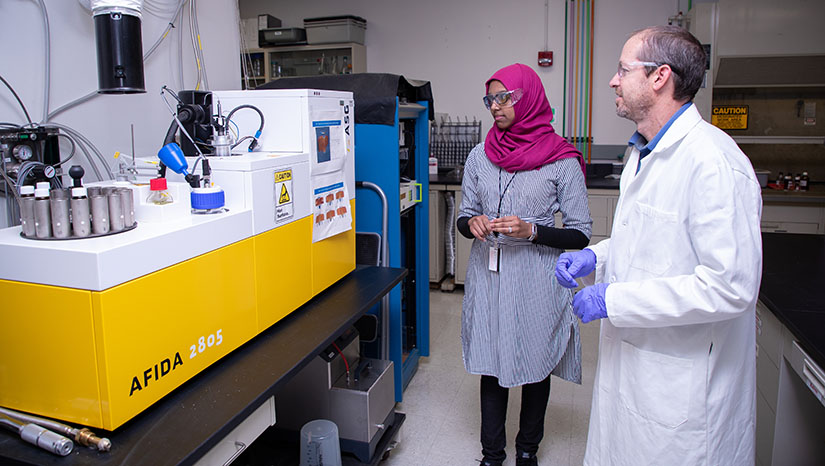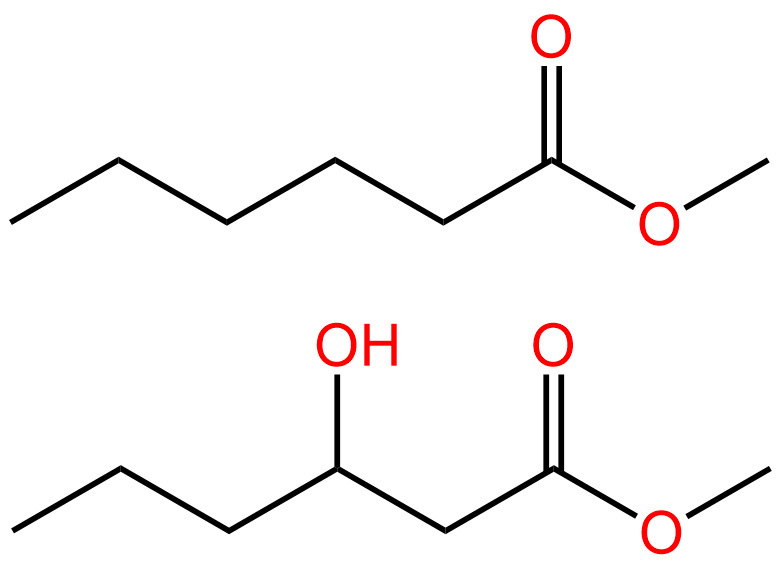Mastering the Fundamentals: A First Step for Promising New Sustainable Vehicle Fuels
Two NREL Reports Detail Findings on Fundamental Fatty Acid Methyl Esters (FAME) Fuels Research in Partnership With ExxonMobil and Genomatica

NREL researchers Jon Luecke (right) and Samah Mohamed perform fuel analyses using an Advanced Fuel Ignition Delay Analyzer (AFIDA) in the Fuels Lab. Photo by Joe DelNero, NREL
While the demand for climate-warming fuels like petroleum and diesel is expected to peak before 2030, the global energy demand for alternative fuels to power vehicles to transport people, goods, and services will grow rapidly in the coming years. Researchers at the National Renewable Energy Laboratory (NREL) recently studied whether a new type of biofuel, produced by genetically engineered bacteria, could be part of the solution.
Biomass-based diesel has an overall smaller carbon footprint than conventional diesel because it is not made from fossil fuels. Today's biomass-based diesel is primarily produced by processing fats and oils from plant matter and animal products, known as "feedstocks."
"We're producing about four billion gallons a year of fats and oils for conversion to fuels, with about half of that going to biodiesel in the United States today," said NREL's Bob McCormick, a senior research fellow. "But we use 46 billion gallons of diesel a year for transportation. It's a bottleneck that is slowly being alleviated by conversion of other forms of biomass ."
To fill the gap between demand and production of biodiesel, finding new feedstocks and methods for production of biomass-based diesel is a top priority. NREL's fuels and combustion researchers are leading efforts to identify whether these discoveries can safely and appropriately meet the need.
NREL researchers, in partnership with ExxonMobil, investigated the properties of a new type of biofuel made by E. coli bacteria engineered to feed on sugar to produce fatty acid methyl esters (FAME), which are similar to the compounds that make up biodiesels. The bacteria, engineered by biotechnology company Genomatica, made a unique FAME with properties that made it different from conventional biodiesel made from, for example, soybean oil. NREL's partners wanted to know whether the new fuel had any advantages relative to conventional biodiesel or if there were any performance issues.
NREL's fuels and combustion researchers recently published two papers detailing their findings on these different properties—and showing why such fundamental research is a necessary step to creating well-vetted, reliable, and appropriate new vehicle fuels to hasten the clean energy transition.
Experiments Reveal "How" and "Why" of Unique FAME

Current U.S. biodiesel production is primarily reliant on oil from soybeans (pictured) or from recycled restaurant cooking oil. Photo by Warren Gretz, NREL
Any fuel that is going to go into an engine needs to meet specific standards, like those set by global organization ASTM International and adopted into United States regulations. These standards ensure fuel safety, quality, and reliability. While new fuels can be exciting, their promise lies in their ability to meet these specifications. That is where NREL's fuels and combustion scientists and advanced research equipment come in.
"We help biofuels researchers and producers develop their technologies by showing them how they are performing, compared to how they need to perform," McCormick said.
McCormick was the lead author on one of the two papers published by the research group, "Fuel Property Evaluation of Unique Fatty Acid Methyl Esters Containing β-Hydroxy Esters from Engineered Microorganisms," published in Fuel Communications.
NREL's team of researchers ran experiments to compare the combustion properties of the unique FAME to conventional biodiesel and built a "chemical kinetic model" for combustion of the unique FAME. The chemical kinetic model is a mathematical representation of the chemical reactions and pathways responsible for the conversion of the fuel material to resulting chemical products throughout the combustion process.
Two main characteristics affect combustion and properties of a biodiesel: carbon chain length and degree of saturation of those chains. In their experiments, the team assessed the combustion properties of the unique FAME relative to conventional soy biodiesel, with the unique FAME having a shorter carbon chain length, different degrees of saturation of those chains, and the presence of a hydroxyl group, which is not present on conventional fatty acid methyl esters.
These molecular-level differences may seem small, but they can make all the difference in a fuel's real-world engine combustion and emissions levels as well as the ability of the fuel to be handled by fuel distributors and users. Qualities that could be impacted include resistance to oxidation (oxidation stability), temperature below which a fuel develops crystals that could plug the fuel filter (cloud point), and a fuel's reactivity for igniting (cetane number). These qualities are just some of many that must be adequate (or fit for purpose) for use in a diesel engine.
To measure and identify physical properties and performance of the unique FAME, the researchers compared different types and mixtures of the material. First, they compared the properties of a unique FAME blend produced via the Genomatica bacteria process (a mixture of about 10% beta-hydroxy FAME with conventional FAME that had a shorter chain length and fewer carbon-carbon double bonds than conventional biodiesel) to conventional soy oil-derived biodiesel, to understand if there were performance advantages or deficits to the blend.
Next, they compared the properties of nearly pure beta-hydroxy FAME with analogous FAME molecules that did not have the hydroxyl group. This comparison allowed them to assess how the beta-hydroxyl group affects fuel properties and combustion.
These laboratory tests and the team's chemical kinetic modeling help set the stage for potential future engine experiments and modeling.

For the fundamental combustion experiments and simulations, researchers used "surrogate" compounds to represent the conventional and unique FAME molecules. These surrogates had similar combustion behaviors to the molecules they were investigating but were simpler and easier to work with. Pictured: Surrogates representing a conventional biodiesel FAME molecule (top) and a unique FAME molecule (bottom), showing the additional beta-hydroxyl group (OH). Figure by Samah Mohamed, NREL
"You would think, 'If I want to test a fuel, I need to test it in an engine.' But engine experiments are very complex," said NREL Fuels and Combustion Researcher Samah Mohamed. "So, to understand a fuel's combustion characteristics, we run fundamental experiments in conditions similar to those in engines, coupled with chemical kinetic simulations."
One of these experiments includes measuring ignition delay time, which is the time required for a fuel-air mixture to ignite, determining a fuel's cetane number. Another experiment assesses the distribution of produced species, to identify the compounds formed during combustion, and helps in predicting emission characteristics of the fuel.
Mohamed is the lead author on the other paper, "Effect of the β-hydroxy group on ester reactivity: Combustion kinetics of methyl hexanoate and methyl 3-hydroxyhexanoate," published in Combustion and Flame. Chemical kinetic models like the one Mohamed and her team created of the unique FAME are a necessary step to understanding not just how a fuel behaves, but why. Understanding the "why" can help streamline research on new fuels coming online in the future that may have similar physical characteristics and can therefore be predicted to behave in certain ways.
To establish the validity of the chemical kinetic model that Mohamed and her coauthors built, the researchers compared the predictions of their model to the data they gathered from the earlier fundamental flow reactor experiments and ignition delay time measurements. Then, they studied the similarities and differences between their unique FAME model and an existing model of a conventional biodiesel.
Balancing Optimism and Realism To Make Informed Decisions
The researchers found their results were mixed but ultimately determined the unique FAME had some combustion and chemical properties that could make it a better fuel than conventional soy biodiesel. Additionally, the unique FAME's shorter chain length and higher degree of saturation compared to conventional biodiesel lower the boiling point and increase the cetane number leading to better combustion, especially for use of the unique FAME at 100% (without blending with petroleum diesel).
The extra beta-hydroxy group presented a challenge. Most significantly, the researchers found that the unique FAME tended to oxidize faster in storage, which can lead to issues in engine operation. Oxidation can cause engines to develop deposits that reduce efficiency and cause blockages. The research team suspects the beta-hydroxy ester may be the cause.
In the papers, Mohamed, McCormick, and other authors from NREL, Colorado State University, Princeton University, and ExxonMobil identify potential solutions that would make the unique FAME work as a fuel—antioxidant additives, for example, or having the engineered microbes produce a similar fuel to the unique FAME but without the beta hydroxy esters (yes, that is possible). However, it will be up to producers, product developers, and those who approve new fuels to make the final decision.
For this group of researchers, being able to conduct fundamental research to study the possibilities and help inform decisions targeting fuel design and production is satisfying enough.
"Using as many of my skills and my knowledge in developing kinetic models to help accelerate the screening of new proposed fuels is what drives me," Mohamed said. "Biofuels researchers are continuously innovating processes to produce potential alternative fuels, and it's important to make sure that these fuels actually work."
Learn more about NREL's sustainable transportation and mobility research. And sign up for NREL's quarterly transportation and mobility research newsletter, Sustainable Mobility Matters, to stay current on the latest news.

